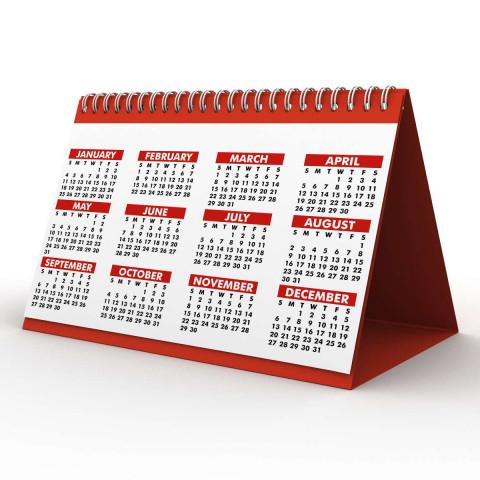Do you know how to say Korean dates (months, weeks, days, and years)? In this blog, we’re going to introduce not only days of the week in Korean, but also hours, seconds, and much more important vocabulary for learning Korean dates and times. Before we take a closer look at date and time in Korean, let’s look at the Korean dates format.
Table of Contents
- How are Dates Usually Written and Read in Korean?
- How to Say the Years in Korean
- Korean Dates: Months
- How to Say Korean Calendar Dates
- Saying the Days of the Week in Korean
- How to Say the Hours in Korean
- How to Say the Minutes in Korean
- How to Say the Seconds in Korean
- How to Say Other Time-related Words
- Interesting Korean Celebration Days
- Let’s Practice
- How KoreanClass101 Can Help You with Korean
1. How are Dates Usually Written and Read in Korean?
In Korea, the order of the date is written: 1.) Year, 2.) Month, and 3.) Day. We’ll explain this in more detail later, but for now, here’s how you need to write dates in Korean: [“year”]년 (nyeon), [“month”]월 (wol), [“day”]일 (il).
For example, let’s say that today is the 26th of January, 2019. In Korean, it’s written as 2019년 1월 26일 (icheonsipgunyeon irwol isibyugil), or “2019, January 26th.” If this order is the same in your country, then it shouldn’t be too difficult for you. But if the order is different in your country, then it can be confusing sometimes.
This is especially important to keep in mind when you purchase a product that has an expiration date written on the package. Sometimes the first two numbers of the year aren’t included in the expiration date either (e.g. “90” instead of “1990”), so don’t get confused about the date. For example, when you see an expiration date of 20/09/21, it doesn’t mean “20th of September, 2021”; it’s “September 21th, 2020.”
Now, let’s learn more important information about dates in South Korea.
2. How to Say the Years in Korean
If you’re not familiar with numbers in Korean, it’s a good idea to first become familiar with the simpler numbers. Once you have a good understanding of Korean numbers, dates will become a lot simpler.
As you may already know, there are two ways to count numbers in Korea: Sino Korean and Native Korean. To count the years, you’ll only need Sino Korean numbers.
For example, if you were born in 1985:
- 1000, read as 천 (cheon), meaning “one-thousand”
- 900, read as 구백 (gubaek), meaning “nine-hundred”
- 80, read as 팔십 (palsib), meaning “eighty”
- 5, read as 오 (o), meaning “five”
All together, it becomes 천구백팔십오 (cheongubaekpalsibo), meaning “one thousand nine hundred eighty five.”
To say “the year,” you need to say 년 (nyeon). So to say, “The year of 1985,” it becomes 천구백팔십오년 (cheongubaekpalsibonyeon).
In Korea, there’s a number of ways to ask which year someone was born in:
- 몇년생이에요?
Myeonnyeonsaengieyo?
“Which year were you born in?” - 몇년도에 태어났어요?
Myeonnyeondoe taeeonasseoyo?
“Which year were you born in?” - 몇살이에요?
Myeotsarieyo?
Technically, it means “How old are you?” but you can answer by stating the year, too.
From 2002 to 2019
| Korean | Romanization | Translation |
|---|---|---|
| 2002년 (이천이년) | 2002nyeon (icheoninyeon) | “The year 2002” |
| 2003년 (이천삼년) | 2003nyeon (icheonsamnyeon) | “The year 2003” |
| 2004년 (이천사년) | 2004nyeon (icheonsanyeon) | “The year 2004” |
| 2005년 (이천오년) | 2005nyeon (icheononyeon) | “The year 2005” |
| 2006년 (이천십육년) | 2006nyeon (icheonsibyungnyeon) | “The year 2006” |
| 2007년 (이천칠년) | 2007nyeon (icheonchillyeon) | “The year 2007” |
| 2008년 (이천팔년) | 2008nyeon (icheonpallyeon) | “The year 2008” |
| 2009년 (이천구년) | 2009nyeon (icheongunyeon) | “The year 2009” |
| 2010년 (이천십년) | 2010nyeon (icheonsimnyeon) | “The year 2010” |
| 2011년 (이천십일년) | 2011nyeon (icheonsibillyeon) | “The year 2011” |
| 2012년 (이천십이년) | 2012nyeon (icheonsibinyeon) | “The year 2012” |
| 2013년 (이천십삼년) | 2013nyeon (icheonsipsamnyeon) | “The year 2013” |
| 2014년 (이천십사년) | 2014nyeon (icheonsipsanyeon) | “The year 2014” |
| 2015년 (이천십오년) | 2015nyeon (icheonsibonyeon) | “The year 2015” |
| 2016년 (이천십육년) | 2016nyeon (icheonsibyungnyeon) | “The year 2016” |
| 2017년 (이천십칠년) | 2017nyeon (icheonsipchillyeon) | “The year 2017” |
| 2018년 (이천십팔년) | 2018nyeon (icheonsip-pallyeon) | “The year 2018” |
| 2019년 (이천십구년) | 2019nyeon (icheonsipgunyeon) | “The year 2019” |
Examples:
- A: 너 몇년생이야?
A: Neo myeonnyeonsaengiya?
A: “Which year were you born in?”B: 나? 2010년.
B: Na? icheonsimnyeon.
B: “Me? In 2010.” - A: BTS의 슈가는 몇년도생이었더라?
A: Bitieseuui syuganeun myeonnyeondosaengieotdeora?
A: “What year was Suga from BTS born in?”B: 1993년!
B: Cheongubaekgusipsamnyeon!
B: “In 1993!”
Quiz:
Are you ready for a quiz? Let’s practice your Korean!
Q1. How do you say “The year of 2001” in Korean?
- 이천삼년 (icheonsamnyeon)
- 이천오년 (icheononyeon)
- 이천일년 (icheonillyeon)
- 이천년 (icheonnyeon)
Q2. What does 이천십팔년 mean in English?
- “The year of 2019”
- “The year of 2018”
- “The year of 2010”
- “The year of 2009”
Q3. How do you write “the year” in Korean?
- 월 (wol)
- 일 (il)
- 년 (nyeon)
- 요일 (yoil)
Answers:
Q1. -> 4
Q2. -> 2
Q3. -> 3
3. Korean Dates: Months
Now we can start learning the days and months in Korean. To say the months is very easy too; just add a number in Korean followed by 월 (wol), which means “month” in the Korean language. For example, to say September: “nine” is 구 (gu) in Korean, followed by 월 (wol), meaning “month.” So it becomes 구월 (guwol), or “September.” Let’s have a look at months in Korean and some examples below:
From January to December
| Korean | Romanization | Translation |
|---|---|---|
| 1월 (일월) | 1wol (irwol) | “January” |
| 2월 (이월) | 2wol (iwol) | “February” |
| 3월 (삼월) | 3wol (samwol) | “March” |
| 4월 (사월) | 4wol (sawol) | “April” |
| 5월 (오월) | 5wol (owol) | “May” |
| 6월 (유월) | 6wol (yuwol) | “June” |
| 7월 (칠월) | 7wol (chirwol) | “July” |
| 8월 (팔월) | 8wol (parwol) | “August” |
| 9월 (구월) | 9wol (guwol) | “September” |
| 10월 (시월) | 10wol (siwol) | “October” |
| 11월 (십일월) | 11wol (sibirwol) | “November” |
| 12월 (십이월) | 12wol (sibiwol) | “December” |
We also have a free online vocabulary list called 한국어로 월에 대해서 말하기 (hangugeoro wore daehaeseo malhagi) or “Talking about Months”, so check it out on our website.
Examples:
- A: 너 몇월에 태어났어?
A: Neo myeochwore taeeonasseo?
A: “Which month were you born?”B: 나? 나 10월에 태어났어.
B: Na? Na 10wore taeeonasseo.
B: “Me? I was born in October.” - A: 부처님 오신날이 언제 였더라?
A: Bucheonim osinnari eonje yeotdeora?
A: “Which month was Buddha’s birthday?”B: 5월 8일!
B: Owol paril!
B: “It’s the 8th of May!”
Quiz:
Are you ready for a quiz? Let’s practice your Korean!
Q1. How do you say “September” in Korean?
- 시월 (siwol)
- 칠월 (chilwol)
- 일월 (ilwol)
- 구월 (guwol)
Q2. Which month has Christmas Day?
- 십이월 (sipiwol)
- 십일월 (sipilwol)
- 팔월 (palwol)
- 이월 (iwol)
Q3. Which month has Children’s Day in Korea?
- 사월 (sawol)
- 오월 (owol)
- 삼월 (samwol)
- 이월 (iwol)
Answers:
Q1 -> 4
Q2 -> 1
Q3 -> 2
3. How to Say Korean Calendar Dates
일 (il) means “one” in Korean, but it also means “day.” To say the days in Korean, use Sino Korean number followed by 일 (il). For example, to answer someone who asks what day Valentine’s Day is on, you can say: 발렌타인데이는 14일이에요 (ballentaindeineun sipsairieyo), meaning “Valentine’s Day is on the 14th.”
Something to remember: “1st” and “2nd” sound very similar in Korean. For this reason, Koreans often ask whether they understood you correctly or not. So if this happens, don’t be discouraged. Your pronunciation is perfect, it’s just how we do things. (We also use the number gestures for better clarity.)
From 1st to 31st
| Korean | Romanization | Translation |
|---|---|---|
| 1일 (일일) | 1il (iril) | “1st” |
| 2일 (이일) | 2il (iil) | “2nd” |
| 3일 (삼일) | 3il (samil) | “3rd” |
| 4일 (사일) | 4il (sail) | “4th” |
| 5일 (오일) | 5il (o-il) | “5th” |
| 6일 (육일) | 6il (yugil) | “6th |
| 7일 (칠일) | 7il (chiril) | “7th” |
| 8일 (팔일) | 8il (paril) | “8th” |
| 9일 (구일) | 9il (guil) | “9th” |
| 10일 (십일) | 10il (sibil) | “10th” |
| 11일 (십일일) | 11il (sibiril) | “11th” |
| 12일 (십이일) | 12il (sibiil) | “12th” |
| 13일 (십삼일) | 13il (sipsamil) | “13th” |
| 14일 (십사일) | 14il (sipsail) | “14th” |
| 15일 (십오일) | 15il (siboil) | “15th” |
| 16일 (십육일) | 16il (sibyugil) | “16th” |
| 17일 (십칠일) | 17il (sipchiril) | “17th” |
| 18일 (십팔일) | 18il (sip-paril) | “18th” |
| 19일 (십구일) | 19il (sipguil) | “19th” |
| 20일 (이십일) | 20il (isibil) | “20th” |
| 21일 (이십일일) | 21il (isibiril) | “21st” |
| 22일 (이십이일) | 22il (isibiil) | “22nd” |
| 23일 (이십삼일) | 23il (isipsamil) | “23rd” |
| 24일 (이십사일) | 24il (isipsail) | “24th” |
| 25일 (이십오일) | 25il (isiboil) | “25th” |
| 26일 (이십육일) | 26il (isibyugil) | “26th” |
| 27일 (이십칠일) | 27il (isipchiril) | “27th” |
| 28일 (이십팔일) | 28il (isip-paril) | “28th” |
| 29일 (이십구일) | 29il (isipguil) | “29th” |
| 30일 (삼십일) | 30il (samsibil) | “30th” |
| 31일 (삼십일일) | 31il (samsibiril) | “31st” |
Examples:
- A: 생일이 언제예요?
A: Saengiri eonjeyeyo?
A: “When is your birthday?”B: 9월 25일이에요.
B: Guworisiboirieyo.
B: “It’s the 25th of September.” - A: 너 여동생 생일이 언제야?
A: Neo yeodongsaeng saengiri eonjeya?
A: “When is your sister’s birthday?”B: 2월20일. 근데 너 왜 내 여동생 생일을 알고 싶은데?
B: Iworisibil. geunde neo wae nae yeodongsaeng saengireul algo sipeunde?
B: “It’s the 20th of February. Why do you want to know my sister’s birthday?”
Quiz:
Q1. How do you say 이월 십삼일 in Korean?
- 2월 13일
- 2월 14일
- 1월13일
- 1월14일
Q2. When is Christmas Day?
- 십일월 이십오일
- 십이월 이십오일
- 십이월 이일
- 사월 이십오일
Q3. How do you say 시월 이십일일 in English?
- “21st of November”
- “21st of April”
- “21st of May”
- “21st of October”
Answers:
Q1 -> 1
Q2 -> 2
Q3 -> 4
4. Saying the Days of the Week in Korean
요일 (yoil) means “day” in the Korean language. Let’s check out days in the Korean language as shown below!
From Monday to Sunday
| Korean | Romanization | Translation |
|---|---|---|
| 월요일 | wollyoil | “Monday” |
| 화요일 | hwayoil | “Tuesday” |
| 수요일 | suyoil | “Wednesday” |
| 목요일 | mongnyoil | “Thursday” |
| 금요일 | geumyoil | “Friday” |
| 토요일 | toyoil | “Saturday” |
| 일요일 | illyoil | “Sunday” |
We also have a free online vocabulary list called 요일에 대해 말하기 (yoire daehae malhagi) or “Talking about Days”. Feel free to check it out on KoreanClass101.
Examples:
- A: 오늘 무슨요일이지?
A: Oneul museunyoiriji?
A: “What day is it today?”B: 오늘? 화요일이야.
B: Oneul? hwayoiriya.
B: “Today? It’s Tuesday.” - A: 내일은 금요일이지?
A: Naeireun geumyoiriji?
A: “Tomorrow is Friday right?”B: 아니, 내일 토요일이야.
B: Ani, naeil toyoiriya.
B: “No, it’s Saturday tomorrow.”
Quiz:
Q1. How do you write “day” in Korean?
- 요일 (yoil)
- 시 (si)
- 년 (nyeon)
- 월 (wol)
Q2. How do you write “Sunday” in Korean?
- 월요일 (wollyoil)
- 화요일 (hwayoil)
- 금요일 (geumyoil)
- 일요일 (illyoil)
Q3. How do you write “Monday” in Korean?
- 일요일 (illyoil)
- 수요일 (suyoil)
- 월요일 (wollyoil)
- 목요일 (mongnyoil)
Answers:
Q1 -> 1
Q2 -> 4
Q3 -> 3
5. How to Say the Hours in Korean
In this section, we’ll focus on “hours” (and not “the time” as in “What time is it?”). If you want to learn how to read the clock in Korean, check out our article titled 시간에 대해 말하기 (sigane daehae malhagi) or “Talking about Time.”
“Hours” in Korean is 시간 (sigan). Let’s have a look at the table below for more vocabulary.
| Korean | Romanization | Translation |
|---|---|---|
| 1시간 (한시간) | 1sigan (hansigan) | “One hour” |
| 2시간 (두시간) | 2sigan (dusigan) | “Two hours” |
| 3시간 (세시간) | 3sigan (sesigan) | “Three hours” |
| 4시간 (네시간) | 4sigan (nesigan) | “Four hours” |
| 5시간 (다섯시간) | 5sigan (daseotsigan) | “Five hours” |
| 6시간 (여섯시간) | 6sigan (yeoseotsigan) | “Six hours” |
| 7시간 (일곱시간) | 7sigan (ilgopsigan) | “Seven hours” |
| 8시간 (여덟시간) | 8sigan (yeodeolsigan) | “Eight hours” |
| 9시간 (아홉시간) | 9sigan (ahopsigan) | “Nine hours” |
| 10시간 (열시간) | 10sigan (yeolsigan) | “Ten hours” |
| 11시간 (열한시간) | 11sigan (yeolhansigan) | “Eleven hours” |
| 12시간 (열두시간) | 12sigan (yeoldusigan) | “Twelve hours” |
Examples:
- A: 비행기가 2시간이나 지연됐어.
A: Bihaenggiga dusiganina jiyeondwaesseo.
A: “The plane got delayed for two hours.”B: 아 정말? 그럼 2시간 뒤에 픽업하러 갈께.
B: A jeongmal? Geureom dusigan dwie pigeopareo galkke.
B: “Oh really? I will come and pick you up after two hours then.” - A: 하루 한시간은 꼭 요가를 하려고 해.
A: Haru hansiganeun kkok yogareul haryeogo hae.
A: “I am trying to do yoga at least one hour per day.”B: 그건 좋은 생각인것 같아. 나는 일주일에 3시간은 꼭 조깅을 하고 있어.
B: Geugeon joeun saenggagingeot gata. Naneun iljuire sesiganeun kkok jogingeul hago isseo.
B: “That’s a great idea. I do jogging for three hours per week.”
Quiz:
Q1. How do you write “hour(s)” in Korean?
- 시간 (sigan)
- 월 (wol)
- 일 (il)
- 년 (nyeon)
Q2. How do you say “twelve hours” in Korean?
- 열시간 (yeolsigan)
- 여덟시간 (yeodeolsigan)
- 네시간 (nesigan)
- 열두시간 (yeoldusigan)
Q3. How do you write “twenty-four hours” in Korean?
- 한시간 (hansigan)
- 이십사시간 (isipsasigan)
- 일곱시간 (ilgopsigan)
- 다섯시간 (daseotsigan)
Answers:
Q1 -> 1
Q2 -> 4
Q3 -> 2
6. How to Say the Minutes in Korean
“Minute(s)” is 분 (bun) in Korean. When you want to write “how many minutes” in Korean, it’s 몇분 (myeotbun).
Let’s have a look at a number of examples:
| Korean | Romanization | Translation |
|---|---|---|
| 5분 (오분) | 5bun (obun) | “Five minutes” |
| 10분 (십분) | 10bun (sipbun) | “Ten minutes” |
| 20분 (이십분) | 20bun (isipbun) | “Twenty minutes” |
| 35분 (삼십오분) | 35bun (samsibobun) | “Thirty-five minutes” |
| 42분 (사십이분) | 42bun (sasibibun) | “Forty-two minutes” |
| 51분 (오십일분) | 51bun (osibilbun) | “Fifty-one minutes” |
| 59분 (오십구분) | 59bun (osipgubun) | “Fifty-nine minutes” |
Examples:
- A: 몇시에 도착할 것 같아?
A: Myeotsie dochakal geot gata?
A: “When do you think you will arrive?”B: 10분안에 도착할께.
B: Sipbunane dochakalkke.
B: “I will be there in ten minutes.” - A: 휴, 캐런은 약속 시간에 맨날 10분 이상 늦더라.
A: Hyu, kaereoneun yaksok sigane maennal 10bun isang neutdeora.
A: “Phew, Karen is always late for at least ten minutes.”B: 야, 내 친구는 한시간이나 늦을때도 있어.
B: Ya, nae chinguneun hansiganina neujeulttaedo isseo.
B: “Hey, my friend sometimes is late for one hour.”
Quiz:
Q1. How do you say “ten minutes” in Korean?
- 삼십오분 (samsibobun)
- 십분 (sipbun)
- 사십이분 (sasibibun)
- 오십구분 (osipgubun)
Q2. How do you say “fifty-nine minutes” in Korean?
- 오분 (obun)
- 십분 (sipbun)
- 오십구분 (osipgubun)
- 사십이분 (sasibibun)
Q3. How do you say “minute(s)” in Korean?
- 년 (nyeon)
- 일 (il)
- 시간 (sigan)
- 분 (bun)
Answers:
Q1. -> 2
Q2. -> 3
Q3. -> 4
7. How to Say the Seconds in Korean
“Second” is 초 (cho) in Korean. Let’s have a look at the table below to practice how to say different “second(s)” in Korean.
| Korean | Romanization | Translation |
|---|---|---|
| 1초 (일초) | ilcho | “One second” |
| 5초 (오초) | ocho | “Five seconds” |
| 13초 (십삼초) | sipsamcho | “Thirteen seconds” |
| 26초 (이십육초) | isibyukcho | “Twenty-six seconds” |
| 30초 (삼십초) | samsipcho | “Thirty seconds” |
| 37초 (삼십칠초) | samsipchilcho | “Thirty-seven seconds” |
| 44초 (사십사초) | sasipsacho | “Forty-four seconds” |
| 52초 (오십이초) | osibicho | “Fifty-two seconds” |
| 59초 (오십구초) | osipgucho | “Fifty-nine seconds” |
Examples:
- A: 1분은 총 몇 초게?
A: Ilbuneun chong myeot choge?
A: “How many seconds in one minute?”B: 60초!
B: Yuksipcho!
B: “Sixty seconds!” - A: 10 초안에 이 문제 풀 수 있겠어?
A: Sip choane i munje pul su itgesseo?
A: “Can you solve this problem in ten seconds?”B:뭐라고? 말도 안돼!
B: Mworago? Maldo andwae!
B: “What? That’s nonsense!”
Quiz:
Q1. How do you write “second(s)” in Korean?
- 분 (bun)
- 년 (nyeon)
- 초 (cho)
- 일 (il)
Q2. How do you write “one minute” in Korean?
- 일초 (ilcho)
- 이초 (icho)
- 삼초 (samcho)
- 사초 (sacho)
Q3. How do you say “sixty seconds” in Korean?
- 오십육초 (osibyukcho)
- 십오초 (sibocho)
- 이십이초 (isibicho)
- 육십초 (yuksipcho)
Answers:
Q1. -> 3
Q2. -> 1
Q3. -> 4
8. How to Say Other Time-related Words
| Korean | Romanization | Translation |
|---|---|---|
| 평일 | pyeongil | “Weekdays” |
| 주말 | jumal | “Weekend(s)” |
| 골든위크 | goldeunwikeu | “Golden Week” |
| 샌드위치 데이* | saendeuwichi dei | “Sandwich Day” |
| 어제 | eoje | “Yesterday” |
| 오늘 | oneul | “Today” |
| 내일 | naeil | “Tomorrow” |
| 엊그저께 | eotgeujeokke | “A few days ago” |
| 그저께 | geujeokke | “The day before yesterday” |
| 내일모레 | naeilmore | “The day after tomorrow” |
Examples:
- A: BTS 콘서트 언제였지? 갑자기 기억이 안나네.
A: Bitieseu konseoteu eonjeyeotji? Gapjagi gieogi annane.
A: “When was the BTS concert? I can’t remember suddenly.”B: 잠깐만… 8월8일이니깐… 어머, 내일모레네!
B: Jamkkanman… parwolparirinikkan… eomeo, naeilmorene!
B: “Hold on… It’s on the 8th of August…oh my goodness, it’s in two days!” - A: 나 엊그저께 친구 결혼식 갔다 왔는데, 둘이 너무 행복해 보였어.
A: Na eotgeujeokke chingu gyeolhonsik gatda wanneunde, duri neomu haengbokae boyeosseo.
A: “I went to my friend’s wedding a few days ago and they both looked really happy.”B: 난 주말에 결혼식 가야 해.
B: Nan jumare gyeolhonsik gaya hae.
B: “I have to go to a wedding this weekend.”
Quiz:
Q1. How do you say “yesterday” in Korean?
- 골든위크 (goldeunwikeu)
- 어제 (eoje)
- 샌드위치 데이 (saendeuwichi dei)
- 엊그저께 (eotgeujeokke)
Q2. How do you say “the day before yesterday” in Korean?
- 내일모레 (naeilmore)
- 어제 (eoje)
- 그저께 (geujeokke)
- 오늘 (oneul)
Q3. How do you say “today” in Korean?
- 오늘 (oneul)
- 엊그저께 (eotgeujeokke)
- 어제 (eoje)
- 그저께 (geujeokke)
Answers:
Q1. -> 2
Q2. -> 3
Q3. -> 1
9. Interesting Korean Celebration Days
Did you know that every month there’s at least one event happening? Korea has many interesting days of celebration and they’re fun to participate in, especially if you’re in a relationship or dating someone. Let’s have a look at some of the most popular celebration days in South Korea:
| Korean | Romanization | Translation | Meaning |
|---|---|---|---|
| 다이어리 데이 (1월 14일) | daieori dei | “Diary Day” | It’s the day that couples give each other their diaries. |
| 발렌타인 데이 (2월 14일) | ballentain dei | “Valentine’s Day” | It’s the day that couples give each other chocolate. |
| 삼겹살 데이 (3월3일) | samgyeopsal dei | “Samgyeopsal Day” | It’s the day to eat Samgyupsal with someone you like. |
| 화이트 데이 (3월 14일) | hwaiteu dei | “White Day” | It’s the day that couples give each other candy. |
| 블랙 데이 (4월 14일) | beullaek dei | “Black Day” | It’s the day to eat Jjajang noodles if you haven’t received any chocolates or candies from anyone. |
| 로즈 데이 (5월 14일) | rojeu dei | “Rose Day” | It’s the day to give a rose to your gf/bf. |
| 키스 데이 (6월 14일) | kiseu dei | “Kiss Day” | It’s the day to give a kiss to your gf/bf. |
| 실버 데이 (7월 14일) | silbeo dei | “Silver Day” | It’s the day to exchange a silver ring with your gf/bf. |
| 그린 데이 (8월 14일) | geurin dei | “Green Day” | It’s the day to walk through the woods with your gf/bf. |
| 치킨 데이 (9월 9일) | chikin dei | “Chicken Day” | It’s the day to eat some fried chicken with someone you like. |
| 포토 데이 (9월 14일) | poto dei | “Photo Day” | It’s the day to take pictures with your gf/bf. |
| 와인 데이 (10월 14일) | wain dei | “Wine Day” | It’s the day to drink some wine with your gf/bf. |
| 무비 데이 (11월 14일) | mubi dei | “Movie Day” | It’s the day to watch a film with your gf/bf. |
| 허그 데이 (12월 14일) | heogeu dei | “Hug Day” | It’s the day to give a hug to your gf/bf. |
10. Let’s Practice
Knowing how to discuss various time frames is important when making a reservation. Let’s imagine that you’re trying to make a reservation at a fancy restaurant to celebrate your engagement with your fiance.
Situation:
- Concierge: 한국호텔입니다. 무엇을 도와드릴까요?
Concierge: Hangukoterimnida. Mueoseul dowadeurilkkayo?
Concierge: “This is a Korean hotel. How may I help you?” - You: 여보세요, 예약하고 싶은데요.
You: Yeoboseyo, yeyakago sipeundeyo.
You: “Hello, I would like to make a reservation please.” - Concierge: 네, 언제로 해드릴까요?
Concierge: Ne, eonjero haedeurilkkayo?
Concierge: “Sure, when would you like to come?” - You: 12월 25일 오후 7시 가능한가요?
You: Sibiwol isiboiril ohu ilgopsi ganeunghangayo?
You: Is it possible on the 25th of December at seven o’clock in the evening?” - Concierge: 확인해보겠습니다. 죄송하지만 12월 25일은 예약이 꽉 차 있습니다. 다른 날은 어떠신가요.
Concierge: Hwaginhaebogetseumnida. Joesonghajiman 12wol 25ireun yeyagi kkwak cha itseumnida. Dareun nareun eotteosingayo.
Concierge: “Let me check it now. I am sorry but it’s full. How about other dates?” - You: 아 그래요? 그럼 12월 26일 오후 7시는 가능한가요?
You: A geuraeyo? Geureom sibiworwol isibyugil ohu ilgopsineun ganeunghangayo?
You: “Oh really? How about on the 26th of December at seven in the evening?” - Concierge: 네 가능합니다. 예약 잡아 드릴까요?
Concierge: Ne ganeunghamnida. Yeyak jaba deurilkkayo?
Concierge: “Yes you can. Do you want me to save the room for you?” - You: 네, 잡아주세요.
You: Ne, jabajuseyo.
You: “Yes please.” - Concierge: 성함과 전화번호 알려주시겠습니까?
Concierge: Seonghamgwa jeonhwabeonho allyeojusigetseumnikka?
Concierge: “May I have your name and your number please?”
11. How KoreanClass101 Can Help You with Korean
We hope you found this blog very informative, and that we helped you learn Korean dates and time! KoreanClass101 has many free online classes and even on online forum to discuss lessons with fellow students. You’ll also find an array of blog posts like this one, and can even learn Korean with your own personal Korean teacher by upgrading your account to Premium Plus. So do check out our website, and have a great day!



















